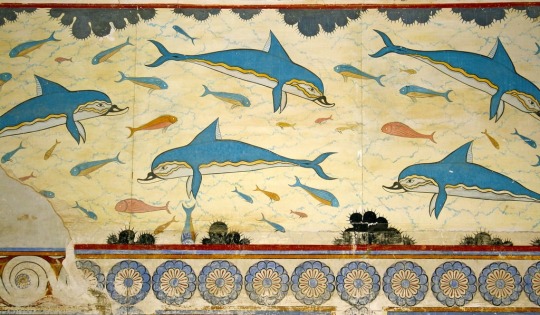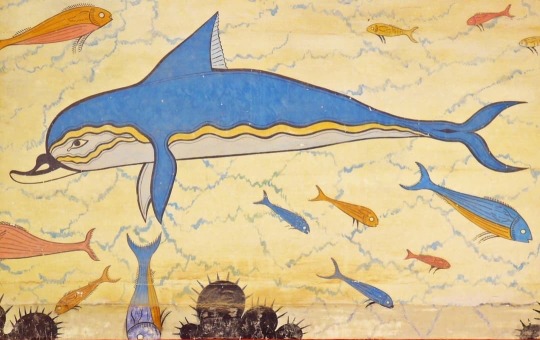#minoan civilization
Explore tagged Tumblr posts
Text

they lived, they served cunt, and then disappeared from history
#minoan#minoan civilization#pre-greek civilization#greek#memes#meme#classic memes#history#ancient greece#shitpost#mycenean#mycenean civilization#homer#the illiad#the odyssey#bronze age#ancient history#ancient world
854 notes
·
View notes
Text

Minoan bull-leaping girls
Art by capelinssm
499 notes
·
View notes
Text


Dolphins Fresco, Palace of Knossos (& detail)
c. 1700-1450 B.C.
#knossos#fresco#dolphins#ancient art#antiquities#minoan civilization#minoan art#minoan#beautiful animals#nature#wildlife#beautiful dolphin#aesthetic#beauty#animals in art#art history#aesthetictumblr#ancient history#ancient world#tumblraesthetic#tumblrpic#tumblrpictures#tumblr art#tumblrstyle#artists on tumblr
2K notes
·
View notes
Text

A 3500-year-old Minoan octopus vase from Palaikastro. Now on display at the Heraklion Archaeological Museum in Crete, Greece.
via: American Institute of the Humanities
172 notes
·
View notes
Text

Dolphins inspired by Minoan frescoes.
References below the cut.

#tagamemnon#minoan#minoan crete#minoan civilization#bronze age#bronze age aegean#dolphin#dolphins#animal art#animal#sea#sea animals#marine biology#digital art#artist on tumblr#fresco painting
213 notes
·
View notes
Text



Minoan frescoes. The 1600s BC was a great time for fashion.
#art#art history#ancient history#history#ancient greece#greece#frescoes#fresco painting#minoan#minoans#minoan civilization#bronze age#fashion#fashion history#history of fashion#ancient civilizations
508 notes
·
View notes
Text

"The prominence of female divinity in Minoan culture might well have reflected the prominence of Minoan women in daily life. In Shang dynasty China, the authority of goddesses such as the Eastern and Western Mothers was echoed to some degree by the authority of women in elite society and even the army. Fu Jing and Fu Hao, wives of King Wu Ding, led men into battle before being honoured in death with monumental tombs containing the victims of human sacrifice, battle axes, knives and arrowheads. In Egypt, many of the images of Hatshepsut were destroyed or defaced after her death when her name was removed from the official list of rulers by her male successors, who sought to claim direct descent from her husband. It is possible that images of powerful Minoan women were subject to similar mistreatment.
While there is no evidence that Minoan women ruled in the same manner as Hatshepsut, or joined battle like the women of Shang China, the sheer number of artworks depicting them centrally placed and on a larger scale than men has prompted some historians to speculate that Minoan society was matriarchal or matrilineal. ‘Neopalatial Crete,’ writes one scholar, ‘presents the best candidate for a matriarchy – if one ever existed.’ There is nothing to say that the position of Minoan women was in any way secondary to that of men.
Minoan women were certainly not confined to the weaving room. Sculptures show them playing lyres, flutes and zithers, sashaying in flounced chevron-patterned skirts and raising their arms in the air in ecstasy. In the ‘Grandstand Fresco’ from Knossos the women are more carefully delineated in paint than the men. Each woman has her own identity, her own style. The women appear to occupy the main rooms of the palace while the men congregate as an anonymous mass beyond. Women depicted seated – a sign of divinity or authority – are often being approached by men or animals. A highly enigmatic fresco at Thera (Santorini), for example, features a woman wearing large hoop earrings, a snake in her hair, and a neck-chain of ducks, sitting on a dais with a griffin beside her while a blue monkey pays her court.
On a gold ring, a female deity, we may presume, is seated beneath a tree, where she receives flowers from two women. A smaller figure of a man with a double-headed axe over his head hovers between them. By depicting the man beneath the axe, and on a smaller scale than the women, the engraver of the ring perhaps hoped to convey that he was a divine vision, almost a thought-bubble, originating in one of the female worshipper’s heads. Trees, as Arthur Evans recognised, were sacred in Minoan culture, and were perhaps believed to be capable of inspiring divine visions in those who honoured them. Such artworks contribute to the picture of Minoan women exerting considerable religious authority in the palace complexes and society more widely.
Minoan women also played a crucial role in ritual. The early Minoans sometimes interred their dead twice by exhuming the bones of their family members and resettling them later in jars. The more usual custom, however, was to bury the dead in chamber tombs or stone beehive-shaped ‘tholos’ tombs, clay sarcophagi or, in the case of infants, under the floorboards of the home. The colourful paintings on a rare limestone sarcophagus from Hagia Triada, circa 1400 bc, show three men carrying young animals and a model boat to the deceased, who stands in front of his tomb, ready to receive his provisions for the afterlife. There are also three women present, the first of whom pours a libation into a cauldron placed between two upright axes mounted by birds; the second carries further vessels; the third – darker skinned like the men and thus possibly of lower social status – has a lyre. On the other side of the sarcophagus the women assist in the sacrifice of a bull on an altar. Other wall paintings show women involved in rituals of their own involving blood. A fresco from Akrotiri features a group of women, one of whom sits beside a sunken room or ‘lustral basin’ with a bleeding foot. A tree also bleeds. It is possible that lustral basins were used for purification by women during or after menstruation."
The Missing Thread: A Women's History of the Ancient World, Daisy Dunn
#history#women in history#women's history#historyedit#minoan women#minoan civilization#bronze age#crete#knossos#ancient history#ancient world#powerful women#historical figures
151 notes
·
View notes
Text

i just realized i havent posted any Minoan girl art on tumblr so here you go 🏺 (might need to turn your brightness up to see this one)
#artwork#didgitalillustration#my art#minoan#ancient greece#bronze age#ancient crete#minoan civilization#minoan crete#historical art#historical oc
135 notes
·
View notes
Text

Minoan civilization
36 notes
·
View notes
Note
What places and times do you take inspiration from for your designs for the Greek pantheon? Demeters crown and Rheas weird hat seem interesting
I've taken a lot of inspiration from the Minoan civilization that flourished on Crete and the other Aegean islands during the Bronze Age. And the Mycenaeans on the Greek mainland who were very influenced by the Minoans. The Mycenaeans spoke an early form of Greek and some of the names of the Greek gods can be traced back to them, though it is not possible to to tell whether they had the characteristics and responsibilities attributed to them later. The script of the Minoans on the other hand, has not yet been deciphered, so we don't know anything about their religion or even what language they spoke.
In my comics the Olympian gods were born during the Late Minoan and Mycenaean period (c. 1700-1100 BCE), so I often use their clothes and hairstyles as inspiration for the gods, but sometimes also the fashion from the Archaic and Classical periods, since I have those periods as models for the "present time" in the comics. Demeter's crown was taken from a Minoan figurine called the Poppy Goddess. Rhea wears a similar hat as women of importance (or goddesses) sometimes are depicted with in Minoan and Mycenaean art.



33 notes
·
View notes
Text


The Prince of lilies and a gryphon
Art by capelinssm
31 notes
·
View notes
Text

🧜♀️Historical Mermay🧜♀️ by @/chloe.z.arts
Minoan Mermaid
#historical mermay#Mermay#Mermay 2024#Fashion history#Historical fashion#Ancient fashion#minoan civilization#Minoan crete
130 notes
·
View notes
Text

Breaking News: Lost Minoan Fresco Unearthed for the First Time in Decades
In what seemed to be a twist of fate, construction workers building an apartment in Heraklion, Greece, discovered a fresco which was believed to have dated back from the Greek Bronze Age. The fresco depicted three dancing female entities against a blue background, similar to those from the Ladies in Blue fresco, except for the fact that the entities bore similar resemblances to characters from the popular Vocaloid franchise, due to their unusual hair colors. According to one construction worker, who asked not to be named, "It reminded me of my daugther's Vocaloid obsession back home. Everyday she'd sing all those Vocaloid songs everytime she'd go home from school."
It is currently hypothesized that the three female entities were music goddesses, venerated by the Minoans, before mutating into the Muses, patron deities of the arts in Greek myth.
50 notes
·
View notes
Text

Based on @kurj's beautiful bull-leaping drawings (sorry for tagging you again, it's just I have noticed that Tumblr hides my recent art pieces from the tags for some unknown reason)
It was really fun doing this piece.
References used:



#bande dessinée#minoan women#minoan crete#minoan#minoan civilization#bull leaping#taurocathapsia#asterix#bronze age aegean#bronze age#tagamemnon#ancient greece#ancient crete#artist on tumblr
63 notes
·
View notes
Text

stone vessel, rhyton in the form of a bulls head Crete, neopalatial period, late minoan IB or II-IIIA1, ca. 1550-1500 BC material: serpentine / black steatite tip of muzzle to top of head (without horns): 20 cm findspot: Knossos, little palace
95 notes
·
View notes
Text

Greek Archaeologists Discover Mysterious 4,000-Year-Old Building on Hill Earmarked for New Airport
Archaeologists on the Greek island of Crete have uncovered a monumental ancient structure that threatens to halt progress on the construction of a new airport.
The structure belonged to the Minoan civilization and was mainly used between 2000 and 1700 B.C.E., around the same time that Crete’s monumental palaces at Knossos and Phaistos were built, per the Greek City Times.
But unlike these palaces and other feats of Minoan architecture, the purpose of the building remains unknown, and it’s now the subject of much archaeological attention and speculation.
The structure resembles “a huge car wheel from above,” writes Nicholas Paphitis for the Associated Press, with a diameter of 157 feet and a total area of 19,000 square feet.
According to a statement from the Greek Ministry of Culture, some of the structure’s features are comparable to Minoan tombs, including its circular arrangement of stone rings and its intricate layout. But a large quantity of ancient animal bones found nearby is complicating researchers’ understanding of the site.
“It may have been periodically used for possibly ritual ceremonies involving consumption of food, wine and perhaps offerings,” says the statement, per a translation by the AP.

While archaeologists further excavate and study the building, which sits on top of Papoura Hill, near the town of Kastelli, they must contend with the hilltop’s future function: a planned radar station for Crete’s new international airport.
Beginning in 2027, the airport will serve Heraklion, Crete’s capital and largest city, as well as a wealth of cultural and archaeological sites across the island.
Eighteen million passengers are projected to use the airport annually once construction is complete, the AP reports. Tourists want to visit Crete’s well-preserved historical sites, but they need convenient, modern infrastructure to take them there.
At times, rampant tourism threatens the integrity of ancient sites in Greece, prompting the government to take protective measures, like limiting the number of visitors to the Acropolis in Athens.

Per the statement, excavations in the area uncovered at least 35 other archaeological sites. As Greek authorities build Crete’s new airport and the network of roads needed to connect it with the rest of the island, they must continually strike a balance between innovation and maintaining cultural heritage.
In the statement, Culture Minister Lina Mendoni describes the structure as a unique find of great interest. She says the Greek government and airport officials will explore alternative locations for the radar station to ensure the preservation of this historically significant archaeological site.
“It’s possible to go ahead with the airport while granting the antiquities the protection they merit,” Mendoni adds, per the AP. Her comments offer hope that Crete’s past, present and future will once again be reconciled.
By Eli Wizevich.

#Greek Archaeologists Discover Mysterious 4000-Year-Old Building on Hill Earmarked for New Airport#Crete#Minoan civilization#temple#ancient artifacts#archeology#archeolgst#history#history news#ancient history#ancient culture#ancient civilizations#greek history
62 notes
·
View notes